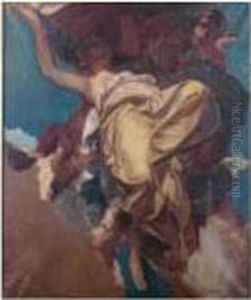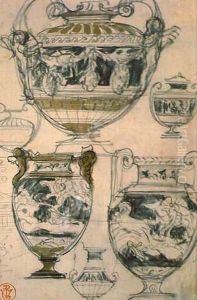Pierre Victor Galland Paintings
Pierre Victor Galland was a distinguished French painter and decorator, known for his significant contribution to the decorative arts during the 19th century in France. Born in Paris on July 15, 1822, Galland showed an early inclination towards the arts, which led him to pursue formal education in painting. He studied under influential figures of the time, including François-Édouard Picot and École des Beaux-Arts in Paris, which were central to his development as an artist.
Galland's artistic journey was marked by his deep interest in decorative painting and the revival of Renaissance and classical motifs, which were popular during his time. His work was characterized by meticulous attention to detail, vibrant colors, and a harmonious blend of classical elegance with contemporary styles. He became widely recognized for his murals and decorative works in public buildings, churches, and private residences across France.
One of the highlights of his career was his contribution to the decoration of the Hôtel de Ville, Paris, which is considered one of his masterpieces. Unfortunately, much of his work in the Hôtel de Ville was destroyed during the Paris Commune in 1871, a devastating loss to the art community. Despite this setback, Galland continued to receive commissions and accolades for his work, including his contributions to the Panthéon in Paris and various other significant projects.
Galland was also a respected teacher, passing on his knowledge and passion for art to the next generation of artists. He taught at the École des Beaux-Arts, where he influenced many students with his emphasis on decorative arts and historical painting techniques.
Pierre Victor Galland's legacy is preserved through his contributions to the decorative arts, which remain influential in the field. His dedication to reviving and innovating within the decorative arts has left an indelible mark on the history of French art. Galland passed away on December 30, 1892, in Paris, leaving behind a rich body of work that continues to be celebrated for its beauty and historical significance.












